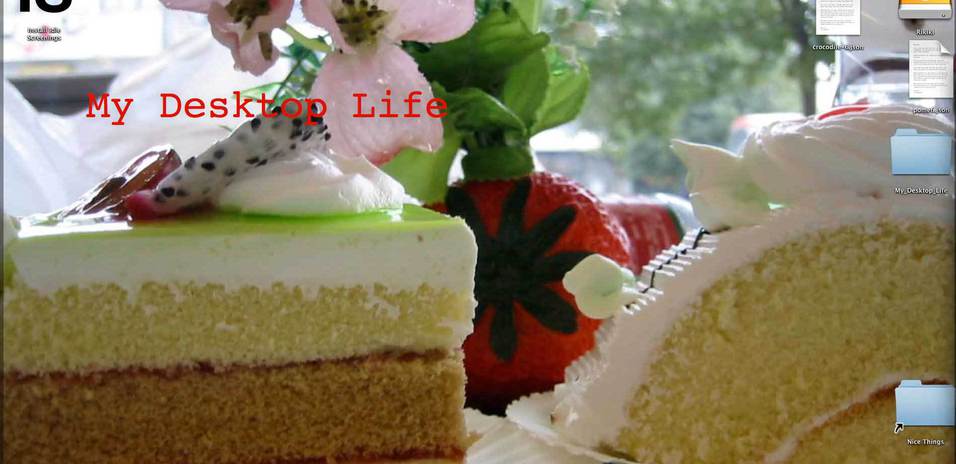Martine Neddam (NL)
My Desktop Life

Narrations are created from what’s on your computer desktop.

Here you can create your own ‘mental space.’

An alternative representation of yourself.
Close

Screenshot from Neddam.org
Share
About Martine Neddam
Martine Neddam is known for her pioneering work Mouchette.org (1996) and has been working for years with how to play with identity constructions in the online-sphere. Narratives and the use of language have always been dominating in Neddam’s work, which often focuses on representation and self.
The Mouchette project centers on a presumed teenager, who published content concerning her darker side of life on the website Mouchette.org. The project has even gathered a community of followers and has become an alternative social network in itself; in fact before social media was even a used practice. In the Mouchette project, Neddam works with anonymity as a strategy for her pieces and until recently didn’t reveal her real identity to the public.
Neddam’s work also includes other identity projects like David Still (2001), which offers web surfers to borrow his identity by using his email for communication; the Chinese virtual person Xiao Quian (2006), and the online interface Virtual Person (2008) that enables the user to create their own virtual characters.
Close
 Share
Share
About the artwork: My Desktop Life
In the Performing the Media exhibition, Neddam will show her latest work on identity representation called My Desktop Life, which is a tool to create stories of yourself using what is on your desktop as elements in a narrative structure. The tool creates small portrait films of the person in question.
The project focuses on remembering through the desktop and creating what Neddam calls ‘a mental space’, which is manifested through a narration based on data-elements found on the computer desktop. It is Neddam’s goal to create a CMS system to be used by people to create their own narrations and desktop lives.
In today’s overflow of tools and sites for self-expression, Neddam creates a more illustrative and poetic, non-profit alternative to the well-known, data-collecting sites for self-publishing. It is also Neddam’s idea to center around how difficult it is to find a visual identity, how this can differ and doesn’t necessarily have to be centered on your face as the main recognizable element. The project also encapsulates how different contextualizations and visual combinations can create new spaces of communication and intimacy for the users.

Narrations are created from what’s on your computer desktop.

Here you can create your own ‘mental space.’

An alternative representation of yourself.

Screenshot from Neddam.org
About Martine Neddam
Martine Neddam is known for her pioneering work Mouchette.org (1996) and has been working for years with how to play with identity constructions in the online-sphere. Narratives and the use of language have always been dominating in Neddam’s work, which often focuses on representation and self.
The Mouchette project centers on a presumed teenager, who published content concerning her darker side of life on the website Mouchette.org. The project has even gathered a community of followers and has become an alternative social network in itself; in fact before social media was even a used practice. In the Mouchette project, Neddam works with anonymity as a strategy for her pieces and until recently didn’t reveal her real identity to the public.
Neddam’s work also includes other identity projects like David Still (2001), which offers web surfers to borrow his identity by using his email for communication; the Chinese virtual person Xiao Quian (2006), and the online interface Virtual Person (2008) that enables the user to create their own virtual characters.

About the artwork: My Desktop Life
In the Performing the Media exhibition, Neddam will show her latest work on identity representation called My Desktop Life, which is a tool to create stories of yourself using what is on your desktop as elements in a narrative structure. The tool creates small portrait films of the person in question.
The project focuses on remembering through the desktop and creating what Neddam calls ‘a mental space’, which is manifested through a narration based on data-elements found on the computer desktop. It is Neddam’s goal to create a CMS system to be used by people to create their own narrations and desktop lives.
In today’s overflow of tools and sites for self-expression, Neddam creates a more illustrative and poetic, non-profit alternative to the well-known, data-collecting sites for self-publishing. It is also Neddam’s idea to center around how difficult it is to find a visual identity, how this can differ and doesn’t necessarily have to be centered on your face as the main recognizable element. The project also encapsulates how different contextualizations and visual combinations can create new spaces of communication and intimacy for the users.